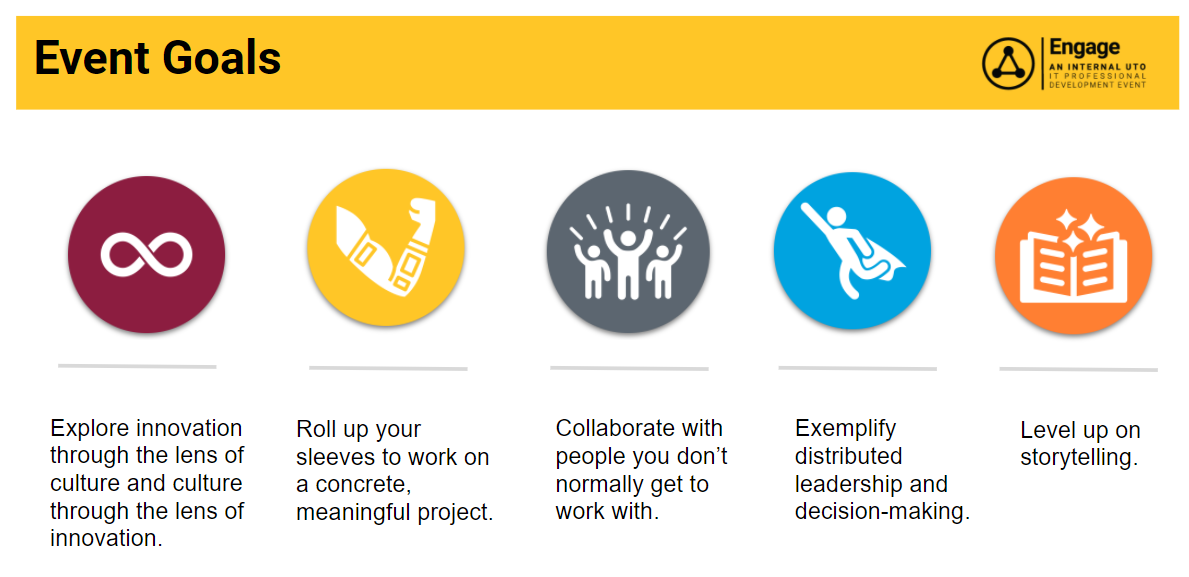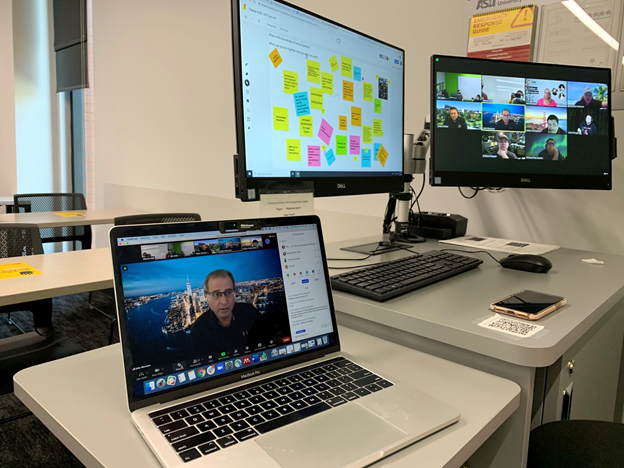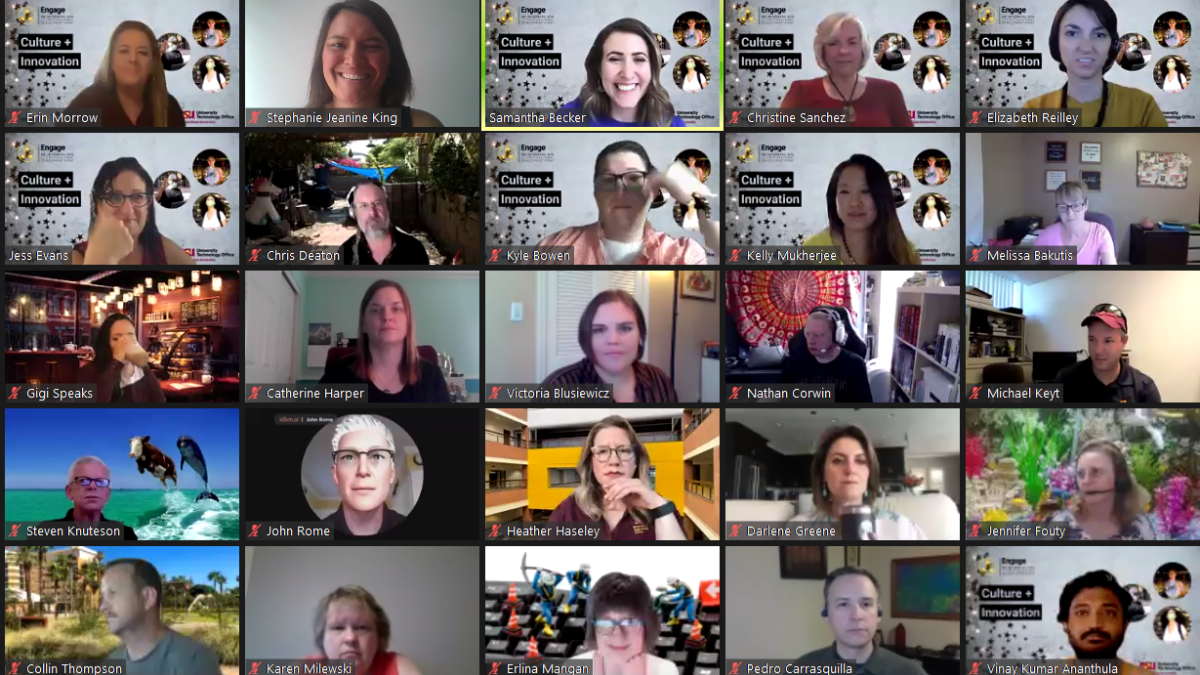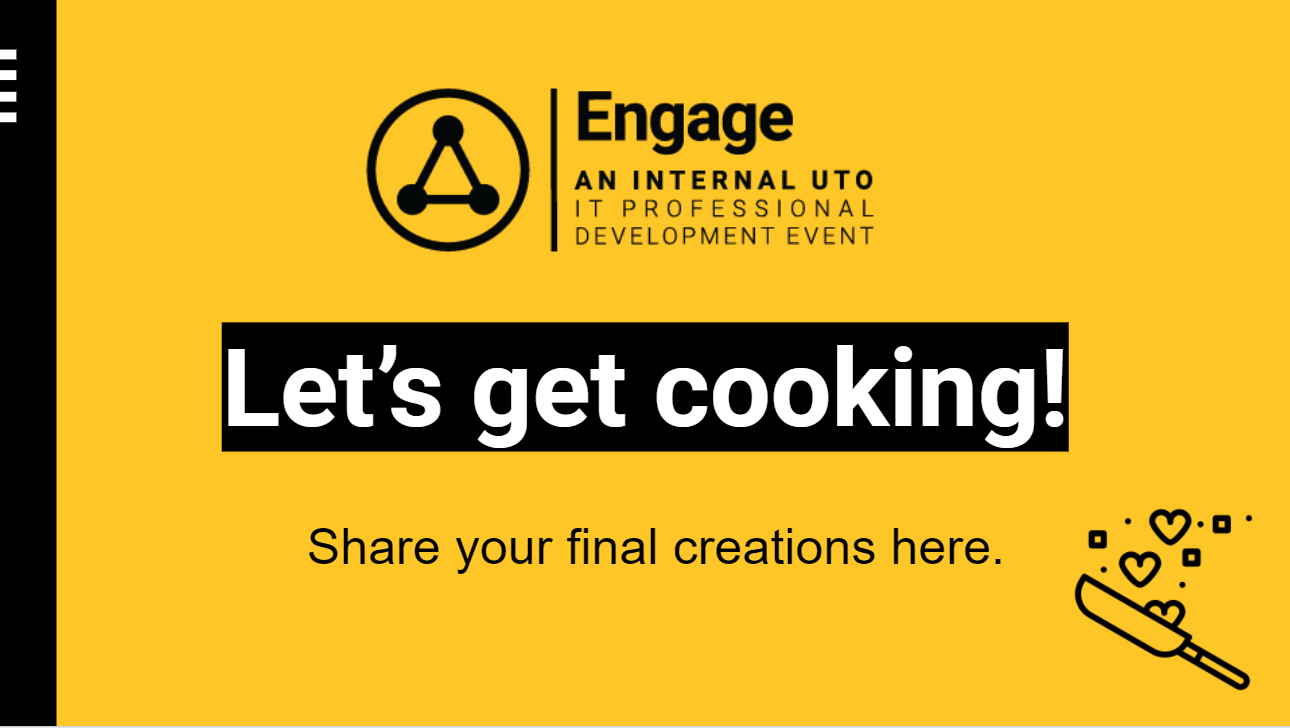This year's third annual Engage event brought together more than 300 ASU University Technology Office (UTO) staff members across nine work streams to take on leadership roles, brainstorm ideas and gain and exercise new skills.
The two-day internal professional development event was held virtually Sept. 23–24.
Following up on the momentum of the ideas constructed by the ASU IT community at Empower 2020, UTO staff spent two hours each day learning, growing and collaborating with colleagues in the form of an idea hackathon. This year’s nine hackathon work streams – submitted by UTO employees and centered around innovation and culture – included:
- Accessible Dashboard of Dashboards.
Activating the Affirmative Pledge.
ASU Sync-Up.
Authentic Artificial Intelligence.
Block-Chain Chain Chain of Tools (See: Aretha!).
Emotionally Smart Cities.
Help Me Help You: Innovative Boundary-Winning Approaches.
Next-Gen Z Networks.
Zooming Out of the Meeting Grid.
But first, a word from our CIO


Samantha Becker, executive director of creative and communications, who co-organized the event, kicked things off by welcoming the UTO family and introducing ASU Chief Information Officer Lev Gonick. He shared examples of the top-notch work that ASU UTO has achieved in the last year, including the university’s Daily Health Check initiative, the transformation of the ASU learning environment via ASU Sync and the hundreds of thousands of calls handled by the ASU Experience Center in recent months.
“As I reflect back to last Engage and many of the work streams, much of what has been accomplished was inspired by conversations (from last year),” Gonick said.
Prep time
Before staff broke out into their hackathon work stream groups, the goals for the two-day immersive event were shared:

They also received tools, best practices and an introduction to all of the work stream concepts from their mashers, or work stream leaders, before breaking into work streams to simmer and sauté their ideas.
Let’s get cooking!
Work stream teams met in Zoom rooms and on the ASU campus in digitally immersive VirBELA to bake their ideas into full-fledged concepts. To ensure there weren’t too many “cooks in the kitchen,” key roles were assigned to each group, including recipe writers (storytellers), sous chefs (facilitators), timers (project managers), and chefs (creators of actionable outputs).
Here's what was cooked up in the nine work streams:
Accessible dashboard of dashboards
“Data reporting via dashboards can seem daunting, mysterious, hard to navigate and accessible,” said masher Elizabeth Reilley, director of data solutions.

To cover a variety of topics, the group divided into three subgroups: reporting and data discovery at ASU; data dictionary interactive navigation; and measuring success. They realized there is a desire to see what success looks like with the help of data. The team is in the process of creating an interactive health chart so that chapters within UTO can identify their status weekly.
Activating the affirmative pledge
In August 2020, UTO published its official affirmative pledge — this working group was tasked with developing plans of action for realizing the affirmative pledge, which resulted in a thought-provoking discussion with many newer UTO family members joining in the conversation.
“It wasn’t easy – things like this aren’t but it was productive,” said Kasey Kautenburger, PeopleSoft application developer associate.
The group talked through leadership engagement and participation, the opportunity to ask anonymous questions, diversity training requirements and the removal of names from job applications until ready to interview.
ASU Sync-up
In the pandemic era, the UTO family has learned a lot about what it takes to support ASU learners in remote and hybrid modalities – this work stream had the task of determining what lessons have been learned from COVID-19.

They used Google Jam Board to ask the questions: What is the advantage of being together? What can you do together that you can’t do apart?
More than 25 answers were centered around six themes, including building community and relationships, immediate feedback and interaction and building presentation confidence. The team plans to continue to work on ways to improve work life in these areas, to maximize their efforts, even when the UTO staff cannot all be together.
Authentic artificial intelligence
Artificial intelligence has been one of the most-featured headline grabbers due to its vast potential — and controversy. There is no shortage of research on inherent racial bias, for example. With Kyle Bowen, executive director of learning experience, leading the working group, they came together to brainstorm how AI can support learning, IT operations, mental health and fitness, and student learning and career pathways.
Block-chain chain chain of tools (See: Aretha!)
The blockchain working group started with an overview of Self-Sovereign Identity (SSI) and blockchain, followed by activities including formulating a problem statement, today statement and a list of potential SSI use cases at the university.
From there, they set out to solve this problem: Because ASU staff have all kinds of digital identities, sharing verified data from and with these sources digitally can be time consuming and difficult. The solution? Eliminate passwords while strengthening account security with a digital identity wallet utilizing blockchain technology.
“I hope the Engage blockchain group participants had their curiosity piqued about blockchain and self-sovereign identity,” said masher Ryan Hendrix, general manager for ASU’s Smart City Cloud Innovation Center. “If these sessions help get people excited and begin to socialize what’s possible with SSI and blockchain in 2025, it’s well worth the time invested.”
Emotionally smart cities
Over the past few years, UTO and ASU have been leading the way for smart campus, city and region advancements, leveraging technology partnerships and the latest tools. The team discussed ideas to create spaces that combine tech, social and environmental innovation with safety and privacy.
The answer? The team suggested creating greenspace that is accessible to everyone, providing natural and artificial light, remotely accessible weather stations and soil analysis, and educational opportunities.
Help me help you: Innovative boundary-winning approaches
When it comes to work, creating boundaries can be easier said than done. The working group broke up into four groups to talk about balance and success, with discussion about the importance of people feeling comfortable speaking up or having heart-to-heart conversations, learning the right time to say “no,” sharing perspectives, allowing for boundaries and the opportunity to recharge.
“I hope participants left feeling more comfortable articulating their needs and perspectives,” said Becker, who was a co-masher for this work stream. “Reciprocal empowerment was a major theme from the group, and I look forward to us making tangible the actionable recommendations we drafted and discussed together for an even more balanced UTO.”
Next-Gen Z networks
Next-Gen Z has entered our college campuses and will be disrupting the workforce in no time. How can UTO help? This working group laid the groundwork on planning an event for Gen Z, combining input from this next generation of students, instructors and current employers. The event would empower Gen Z students to lead the future of learning by encouraging knowledge sharing between the three groups on themes including designing future classrooms and swapping instructors for students for a day.
“I hope the team gained a sense of community, inclusion, engagement and ownership for building a better tomorrow for our community of learners,” said Kelly Mukherjee, mobile/IoT product manager and masher for the Next-Gen Z Networks working group.
Zooming out of the meeting grid
A few dozen participants in this working group were tasked with brainstorming how to make the influx of Zoom meetings that come with working from home more constructive, productive and engaging. It was clear to the group that improving the overall meeting experience had to be tackled first.
“We spent the majority of our time discussing ways to improve, or shift, the best practices of our physical world to enhance our new virtual meeting experiences,” said Chris Deaton, software release manager and masher for the group. “Culturally, we felt that by taking this approach we were putting the respect for our coworkers time and energy as a priority while still finding ways to get the right people, at the right place, for the right amount of time.”
The team came up with a list of suggestions and best practices that they shared with the UTO staff help with productivity and engagment, which they plan to turn into a short video series.
That’s a wrap, check out the Engage Cookbook 2020
To end this two-day event, each work stream shared their final report to their team members in the form of recipe cards. When added together, the event’s work created a 28-page cookbook to reference and inspire for years to come.
“Our work streams certainly did achieve the mashing of culture and innovation by embedding the design element of diversity, equity, inclusion and belonging,” said Christine Whitney Sanchez, chief culture officer and Engage co-organizer, which correlates with Engage’s event goals.
More Science and technology

ASU and Deca Technologies selected to lead $100M SHIELD USA project to strengthen U.S. semiconductor packaging capabilities
The National Institute of Standards and Technology — part of the U.S. Department of Commerce — announced today that it plans to…

From food crops to cancer clinics: Lessons in extermination resistance
Just as crop-devouring insects evolve to resist pesticides, cancer cells can increase their lethality by developing resistance to…

ASU professor wins NIH Director’s New Innovator Award for research linking gene function to brain structure
Life experiences alter us in many ways, including how we act and our mental and physical health. What we go through can even…

